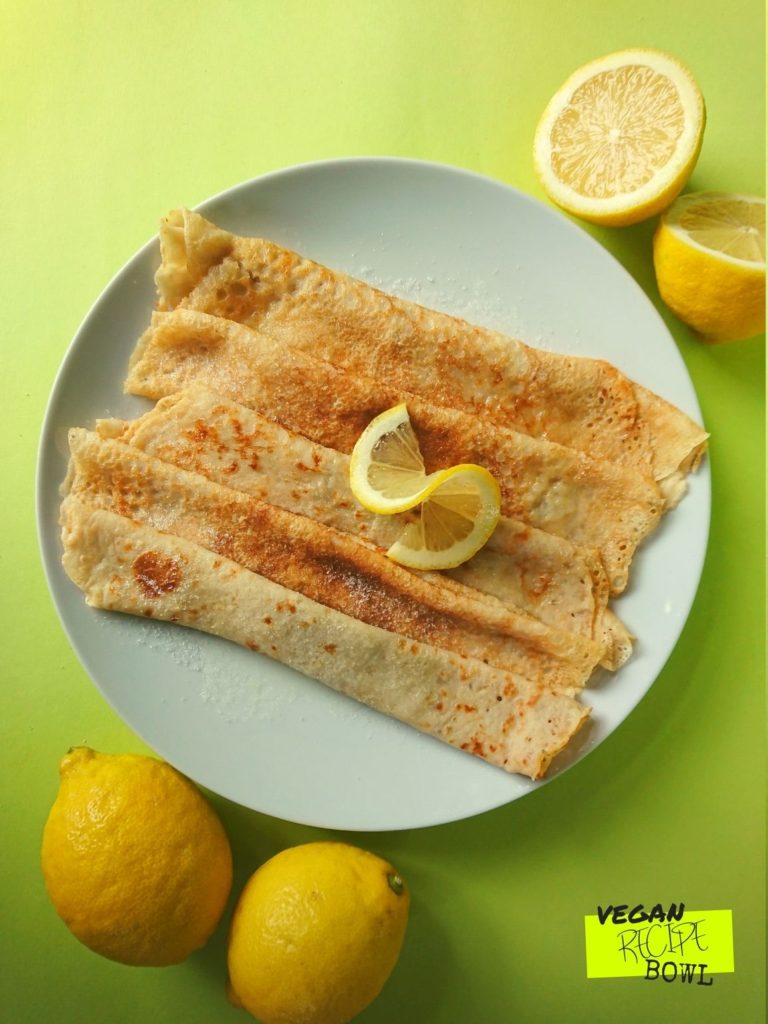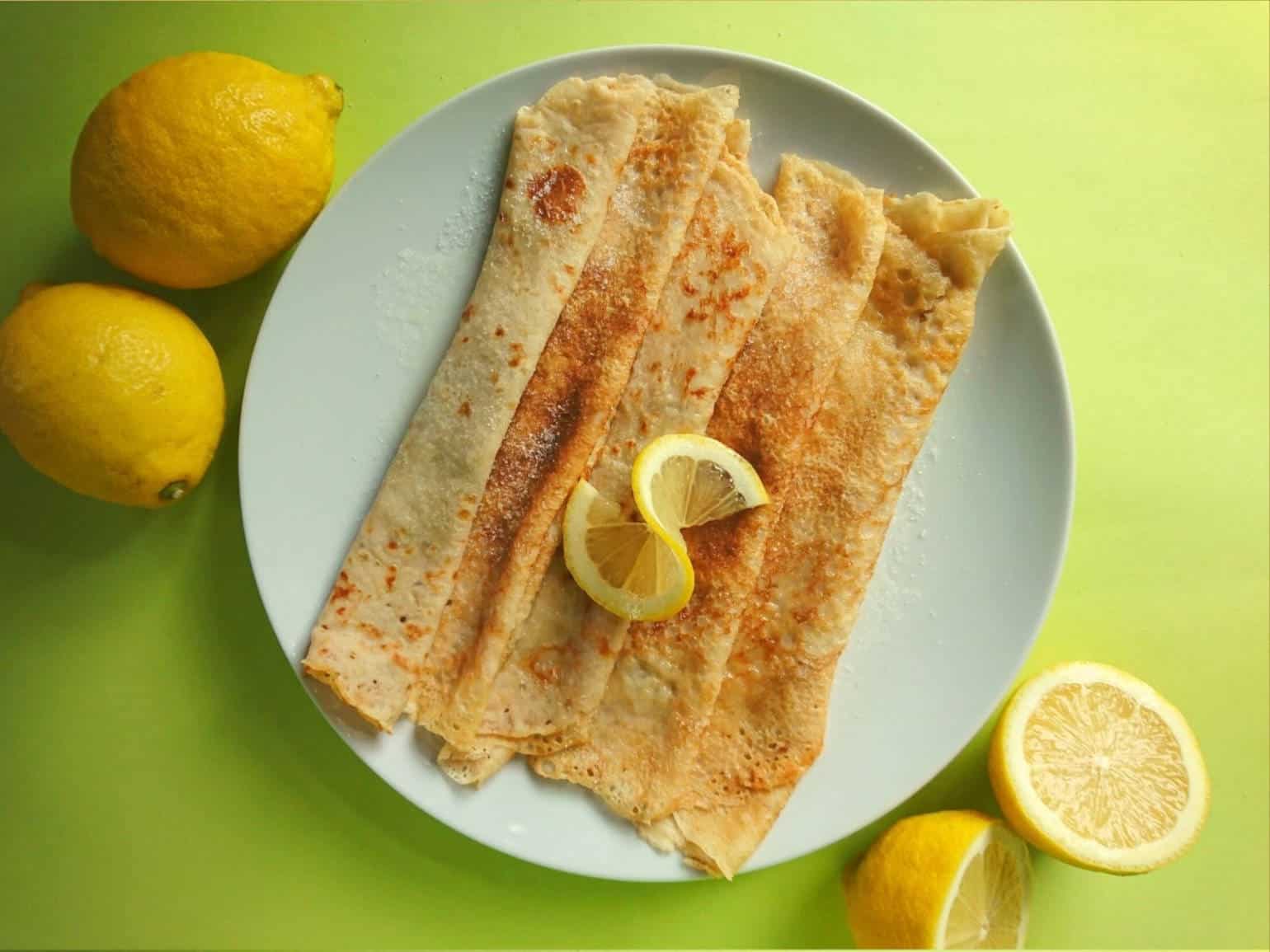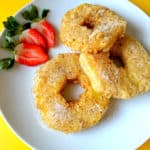
This post contains affiliate links, which means if you purchase something through my link, I will earn a small commission. This does not affect the price you pay for the item. I only advertise products that I have used myself and would genuinely recommend!
These vegan English pancakes are an exact recreation of the classic British pancake recipe. Hot from the pan they’re soft and juicy inside, yet golden and crisp on their surface. Perfect with a squeeze of lemon and sprinkle of sugar – or some maple syrup. They’re totally suitable for savoury pancake recipes too, because there’s no sugar in the batter.
I have a long-term fascination with developing egg-free batters. Previously I’ve created American-style pancakes, pineapple fritters, and onion rings. Plus all kinds of cakes. I’ve also been delighted to guest blog an easy, one-bowl American pancake recipe for egg-truth.com.
English pancakes, however, use a distinctly different batter to all of these, and developing this recipe posed interesting new challenges.
Dairy-free pancakes are easy. Making egg-free pancakes required a new recipe
Replacing dairy milk is normally simple – just use a plant milk. I’ve chosen soy milk because it’s widely available, and its high protein content encourages batters to set and brown well. It’s my favourite dairy-free milk for most cooking and baking, but you can use an alternative plant milk like oat or almond milk – they will work fine too.
Making eggless pancakes is the interesting bit because it involves a whole lot of food science. It was also an excuse to eat loads of pancakes for ‘testing’ purposes… But jokes aside, the recipe needs to be spot on. English pancakes are a popular, much-loved British recipe.
Crucially, these pancakes need something subtle to bind them together. I have nothing against say, banana pancakes, it’s just I want to exactly replicate my original recipe – and that recipe doesn’t taste like bananas.
Enter aquafaba – the liquid from a can of chickpeas. You don’t taste it or know it’s there, but it’s a great egg-replacer that works great at binding batters.
Despite aquafaba being the latest vegan craze (who would have guessed we’d be so excited by the liquid from canned chickpeas a few years ago?!), I’ve not actually had the chance to share a recipe using it yet. Vegan English pancakes seemed are an excellent place to showcase aquafaba’s egg-replacing properties.
You don’t know it’s there when eating them – that’s the beauty of it, but try making the same recipe with the aquafaba replaced with water and everything changes. The pancakes simply fall apart.
Can you freeze aquafaba?
Absolutely, these pancakes work great with previously frozen aquafaba! Just make sure you fully thaw it before use. I freeze 100g quantities just for pancake making, which are perfect to move from the freezer to the fridge the night before making them.
Replacing the egg requires several ingredients working together
Aquafaba is awesome, but there’s a bit more going on here to replace the egg. To keep the pancakes tender and soft – like eggs do – I’m adding a little olive oil to the batter. Also, a good pinch of salt. Eggs are salty, so vegan pancakes taste most authentic with the salt in. However, I’ve realised that the salt is more than a taste issue, I have found the pancakes can be fragile and gummy if I skip the salt. I’ve seen this multiple times and even corrected it halfway through a batch by adding salt to the batter. I’m unsure why this is though. Anyone with any thoughts on this, please share in the comments!
Some cornflour gives tenderness and enhances crisping, while the pinch of baking powder replicates the mild leavening action of eggs.
Together these ingredients work to create the best vegan English pancakes.
Exactly like the traditional version, these English pancakes are neither sweet nor savoury. You can choose the toppings you want and can serve them either way.
Let the batter stand for best results
Letting a batter stand for a while so the flour plumps up before cooking is a classic batter technique – and one I wanted to use in this recipe. With traditional recipes, it makes excellent, tender pancakes. However, doing this made my new, vegan batter too thick to spread around the pan!
To solve this, I split the addition of soy milk. First, we use some to hydrate the flour, let it stand, then add the rest right before cooking. The result is perfect, a thin batter that’s full of nicely plumped-up flour. All of the tenderness benefits, yet it flows out nicely around your pan when pouring.
Pancake making is equally about recipe, frying pan and technique
Like crêpe making, English pancakes rely on a specific cooking technique. Fortunately, it’s easy to replicate when you know how.
When cooking these pancakes it’s essential to use a hot frying pan. The pancake’s surface needs to sear quickly so the pancake is browned and golden, but the inside stays soft.
Oil helps greatly with transferring the heat from the pan quickly, and to give a glossy, golden finish. Crucially, add a little oil right before frying each pancake. Place the oil right into the centre of the hot pan, then pour the batter in to the oil pool. Immediately tilt the pan around to evenly spread the batter. This technique makes the perfect crisp-yet tender pancakes with lacy edges every time.
Choosing a good frying pan
This recipe is developed for a roughly 30cm pan. Keep in mind you can’t move the pancake around so you’ll do best with a thick bottom pan that distributes the heat evenly.
Happy pancake day!
Vegan English Pancakes

This super-easy vegan English pancake recipe makes perfect pancakes every time. Serve hot and fresh from the pan with lemon juice & sugar! Egg-free and dairy-free. Recipe from veganrecipebowl.com
Ingredients
To rest for 30 minutes
- 200 g plain white flour (aka all purpose)
- 2 teaspoons cornflour (aka cornstarch)
- 1/2 teaspoon baking powder
- 1/8 teaspoon salt (do not skip, it affects the pancakes' texture!)
- 300 g soy milk (unflavoured and unsweetened)
- 100 g aquafaba (liquid from a can of chickpeas – shake can well before draining)
- 2 tablespoons light olive oil
To add after resting
- 150 g soy milk (unflavoured and unsweetened)
To fry
- 4 tablespoons sunflower oil (divided in to 1/2 tablespoon for each pancake)
Instructions
- Place all of the ingredients from the "to rest for 30 minutes" list into a large bowl and whisk until a smooth batter forms. Set aside for 30 minutes.
- When you return the batter will have thickened. Add the remaining 150g of soy milk and whisk lightly until combined. The batter will now be quite thin and easy to pour.
- Heat a ~30cm frying pan until it's good and hot. Place 1/2 tablespoon of sunflower oil in to the centre of the pan, then pour 1/3 a cup of the pancake batter in to the middle of the oil – it should sizzle immediately. Promptly tilt the pan about so the batter evenly coats the bottom of the pan. Fry until the underside is golden (1-2 minutes), then flip over with a spatula and fry the other side until it's golden (1-2 minutes).
- Transfer to a plate and serve with any topping of your choosing. Hot or cold, sweet or savoury, they're delicious.
Notes
Flour varies in how much water it absorbs. If your batter is a bit too thick and hard to spread around the pan you can add a little more soy milk as needed. Add modestly though, a tablespoon or two is often enough.
1/3 a cup is about 80ml of batter. If you don’t have a measuring cup to hand, 1/3 of a regular coffee mug should be close enough.
Nutrition Information:
Yield:
8Serving Size:
1Amount Per Serving: Calories: 205Total Fat: 11gSaturated Fat: 1gTrans Fat: 0gUnsaturated Fat: 9gCholesterol: 0mgSodium: 90mgCarbohydrates: 21gFiber: 1gSugar: 1gProtein: 4g




Nice pancakes. In my country we often sprinkle them with sugar, role up and eat cold. They worked good for this too.
Hi Dea, that sounds simple and delicious. I recall some French friends serving crepes like that. Very happy to hear you’ve enjoyed the recipe.
Absolutely brilliant recipe. This will be my go to from now on. I’ve done a few different recipes over the years, this is certainly the best. I reduce the aquafaba the day before (on a gentle simmer for 15 mins) before using it, and refrigerated until I needed it.
Hi Holly, it’s great to hear you’re enjoying the recipe. Really appreciate your feedback too, it helps me make better recipes.
I’m not sure if you’re using aquafaba from a can or from your own home cooked chickpeas? Although both should work, I find canned chickpeas give the most consistent aquafaba. So I designed the recipe for this and just used it straight out the can.
Hope this helps, and enjoy your pancakes!
Hi Fellow pancake fans,
I made this recipe recently and again today. I am using a can of chickpeas for the aquafaba. Today, I just halved the recipe. I knew I had a can of opened chickpeas in the fridge from my last pancake munching and I did not want to waste it. I squeezed every last drop of aquafaba out of the used tin and it weighed 46g. The recipe asks for 150g or 75g halved.
I did not want to open another can, so I used this 46g with half of Ben’s recipe. I was expecting it to turn to sludge, as that’s what happened when I kept diluting it previously after taking it out of the fridge on multiple days later, but it didn’t.
So, to save opening a new can of chickpeas, this worked for me,
Thanks
Lee
Hi Lee, it’s great to hear you’re enjoying these pancakes!
Your 46g of aquafaba wasn’t as far off as you think. The recipe calls for 100g, not 150g. So when you halved it, you were only 4g of aquafaba short.
I’ve also used leftover batter the next day with good results (add in a tablespoon or two of soy milk if needed to thin it), but I’ve not kept it longer than this. Halving it – like you did – is the better option though. I find fresh batter makes the best pancakes.
I found if i made them thinner they were dry, and if thicker they were gluey in middle. Cooked until set they were dry again. I added some chickpea flour, which helped, and put in a plastic bag to keep steam in, which softened them up. I wd use less aqua faba another time, mine was a bit thick which cd have been the problem.
Hi Stephanie, I’m sorry to hear your pancakes didn’t turn out right. I have a few thoughts why this might have happened:
Not adding salt. Any time I forget the salt, I know right away with the first pancake because they have a totally different gummy texture.
Not having the pan hot enough. Pancakes really need a hot pan to set and brown the outside fast enough that the inside doesn’t dry out. There should be a good sizzle and bubbling when the batter goes in.
I’m not sure what was happening with your aquafaba. The type I use for these pancakes is from canned chickpeas (give the can a good shake before draining it out). Because canned chickpeas contain a set amount of chickpeas and water, I find the aquafaba from them is pretty consistent. So although possible to obtain aquafaba from other sources, just using a regular can of chickpeas is the safest option I know of.
I’ve edited the recipe to emphasise these points more strongly to help future readers.
Hope this helps. Thanks again for the feedback!
Thank you so much for this recipe. i’ve tried so many different vegan english pancake recipes and they’ve never been quite right, either the taste or texture is wrong or they’re very hard to flip but this recipe is perfect. Exactly like the non vegan recipe i ate as a kid.
Hi Sarah, it’s great to hear the pancakes worked so well for you! It’s an interesting recipe to veganise because it’s so dependant on eggs, so I’m pleased to hear it’s just like you wanted it. Really appreciate the feedback, Ben
This sounds like a good recipe. Can you tell me why the liquids are measured in grams and not ml, I have always measured liquids either by cups (Canadian way) or liquid ounces. I have never had a recipe that called for liquids to e measured by weight. I am looking forward to trying this recipe tomorrow, Shrove Tuesday.
Hi Jeanette, I like to measure liquids in grams because it’s typically much more accurate than measuring jugs. I’ve found some measuring jugs are wildly inaccurate when I put them to the test. Scales tend to be better, but even if they’re a bit out, any inaccuracies are repeated for all ingredients because the same device is being used, so the crucial thing – the ratios – is maintained. It’s also easier to just pour ingredients straight in the bowl rather than get out some other measuring utensil.
Hope you enjoyed the pancakes!
Vegan but I doubt you’d know it.
Dude, you’re a genius!
Hands down the best vegan pancake recipe I’ve ever tried.
It can’t be overstated – this is a truly outstanding effort.
Thank you, it’s great to hear how much you like the recipe! I was one I spent a lot of time working on so this is good to hear.